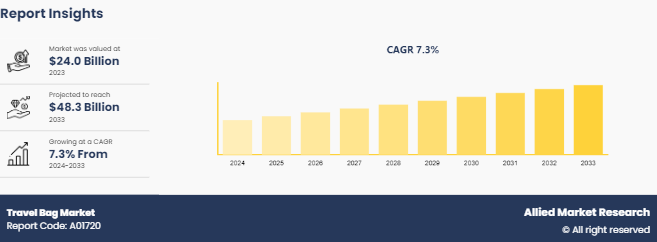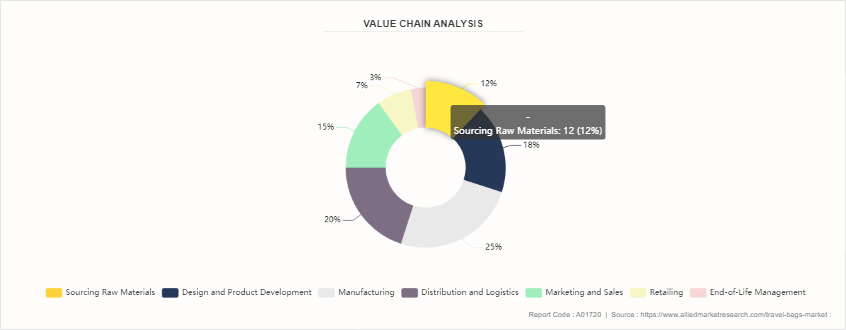Travel Bag Market Research, 2033
Market Introduction and Definition
The global travel bag market was valued at $24.0 billion in 2023, and is projected to reach $48.3 billion by 2033, growing at a CAGR of 7.3% from 2024 to 2033.A travel bag is a type of luggage or carryall specifically designed to hold personal belongings, clothing, and other necessities during travel. It typically features compartments, pockets, and secure closures like zippers to organize and protect items. Travel bags come in various forms, such as suitcases, duffel bags, backpacks, and rolling bags, and are made from durable materials to withstand the rigors of travel. They are often designed with portability in mind, including handles, straps, or wheels for easy transport.

Key Takeaways
The travel bag market study covers 20 countries. The research includes a segment analysis of each country in terms of value ($Million) for the projected period 2023-2033.
More than 1, 500 product literatures, industry releases, annual reports, and other such documents of major industry participants along with authentic industry journals, trade associations' releases, and government websites have been reviewed for generating high-value industry insights.
The study integrated high-quality data, professional opinions and analysis, and critical independent perspectives. The research approach is intended to provide a balanced view of global markets and to assist stakeholders in making educated decisions in order to achieve their most ambitious growth objectives.
Key Market Dynamics
The continuous growth of the global travel and tourism industry drives demand for travel bags, as more people are traveling for leisure, business, and other purposes. Increased disposable income and the trend of experiential travel further boost this demand, increasing the Travel Bag Market size.
Advances in travel bag design, such as lightweight materials, smart luggage features, and ergonomic designs, attract consumers looking for convenience, durability, and enhanced travel experiences. This innovation acts as a significant driver of market growth, increasing the Travel Bag Market share.
Economic downturns, inflation, and currency fluctuations can negatively impact consumer spending on non-essential items like travel bags, leading to reduced market demand. Economic challenges can also affect the frequency of travel, thereby influencing the market and negatively affecting the Travel Bag Market growth.
The travel bag market is highly competitive, with numerous brands offering a wide range of products. This competition, coupled with price sensitivity among consumers, can limit profit margins and make it difficult for new entrants to gain a foothold in the market.
There is significant growth potential for the travel bag market in emerging markets, where rising middle-class populations, increasing disposable incomes, and growing travel activities are creating new opportunities for travel bag manufacturers to expand their presence and capture a larger market share.
Value Chain of Travel Bag Market
The value chain of the travel bag market involves several key stages, each adding value to the final product. It begins with sourcing raw materials like textiles, zippers, and buckles, where sustainability considerations are increasingly important. The design and product development stage follows, with design teams creating prototypes and testing for durability and functionality. Manufacturing takes place in specialized facilities, often in cost-effective regions, with strict quality control to ensure product standards. Once produced, travel bags are stored in warehouses and distributed through a network of logistics providers to retail outlets and online platforms. According to Travel Bag Market forecast, marketing and sales efforts, including branding and advertising, are crucial for differentiating products in a competitive market, and the bags are sold through various channels, including physical stores and e-commerce. Retailers play a significant role in consumer interaction, providing in-store experiences and after-sales support, while consumer feedback informs future product improvements. Finally, as sustainability becomes a priority, end-of-life management, such as recycling or take-back programs, is increasingly integrated into the value chain, enhancing brand reputation and contributing to environmental responsibility.

Market Segmentation
The travel bag market is segmented based on material into hard side, and soft side. The market is also divided by luggage type into duffle, trolley, and backpacks. The market is further sub-divided by different price range, which includes premium, medium range, and low range and by distribution channel into supermarket/hypermarket, specialty stores, factory outlets, online stores, and others. Based on region, the market is categorized across North America, Europe, Asia-Pacific, and LAMEA.
Regional/Country Market Outlook
The U.S. is one of the largest and most mature markets for travel bags, driven by a strong culture of domestic and international travel. The market benefits from high consumer spending power, a well-established retail infrastructure, and a growing emphasis on lifestyle and fashion. The popularity of both leisure and business travel continues to drive demand for a variety of travel bags, from premium to budget-friendly options. The trend toward smart luggage, with features such as GPS tracking and built-in chargers, is particularly strong in the U.S., reflecting the tech-savvy nature of American consumers. According to the U.S. Department of Commerce, the National Travel and Tourism Office (NTTO) reported that U.S. residents made over 93 million international trips in 2019, highlighting the significant demand for travel accessories, including bags, increasing the Travel Bag Market demand.
China represents a rapidly growing market for travel bags, fueled by the increasing middle class, rising disposable incomes, and a surge in both domestic and international travel. The Chinese market is characterized by a strong demand for both affordable and luxury travel bags, with consumers showing a growing preference for high-quality, branded products. The expansion of e-commerce platforms has also played a crucial role in making a wide range of travel bags accessible to a broader audience. According to the China National Tourism Administration (CNTA) , Chinese tourists made over 160 million outbound trips in 2019, a significant increase from previous years, reflecting the growing demand for travel accessories.
Industry Trends
There is a growing trend towards using sustainable and eco-friendly materials in the manufacturing of Travel Bag Industry. Consumers are increasingly conscious of the environmental impact of their purchases, leading to a demand for bags made from recycled materials, organic fabrics, and biodegradable components. Brands are responding by incorporating these materials into their products and highlighting their commitment to sustainability in their marketing efforts. ? According to the World Tourism Organization (UNWTO) , global tourism expenditure reached approximately $1.7 trillion in 2019, demonstrating the significant economic impact of the travel industry. As travel activities increase, the demand for travel-related products, including travel bags, also rises.
The integration of technology into travel bags is becoming more prominent. Features such as built-in USB charging ports, GPS tracking, and RFID-blocking compartments are increasingly common in high-end travel bags. This trend is driven by the desire for convenience and security among tech-savvy travelers. Smart luggage, which can be controlled via smartphone apps, is gaining popularity, catering to the needs of modern travelers who prioritize connectivity and innovation.
Competitive Landscape
The key players profiled in the report are Delsey SA., VIP Industries, TGHI, Inc., Samsonite, Ace Co. Ltd., U.S. Luggage Company, LVMH Group, Travelpro Products, Inc., Rimowa GmbH, and Kering SA.
Recent Key Strategies and Developments
In February 2023, ?Samsonite has launched a licensed collection with New Balance. The products feature reversible pouches with leisure utility as well and high versatility that are suitable for any types of trips.
In January 2024, Louis Vuitton has launched sandwich bag which is made up of rich leather.
Key Benefits For Stakeholders
- This report provides a quantitative analysis of the market segments, current trends, estimations, and dynamics of the travel bag market analysis from 2024 to 2033 to identify the prevailing travel bag market opportunities.
- The market research is offered along with information related to key drivers, restraints, and opportunities.
- Porter's five forces analysis highlights the potency of buyers and suppliers to enable stakeholders make profit-oriented business decisions and strengthen their supplier-buyer network.
- In-depth analysis of the travel bag market segmentation assists to determine the prevailing market opportunities.
- Major countries in each region are mapped according to their revenue contribution to the global market.
- Market player positioning facilitates benchmarking and provides a clear understanding of the present position of the market players.
- The report includes the analysis of the regional as well as global travel bag market trends, key players, market segments, application areas, and market growth strategies.
Travel Bag Market Report Highlights
| Aspects | Details |
| Market Size By 2033 | USD 48.3 Billion |
| Growth Rate | CAGR of 7.3% |
| Forecast period | 2024 - 2033 |
| Report Pages | 256 |
| By Material Type |
|
| By Luggage Type |
|
| By Distribution Channel |
|
| By Price Range |
|
| By Region |
|
| Key Market Players | TGHI, Inc., Delsey SA., Ace Co. Ltd., U.S. Luggage Company, TRAVELPRO PRODUCTS, INC, Kering SA, LVMH Group, Samsonite, Rimowa GmbH, VIP Industries Limited |
Analyst Review
Travel bags consist of bags or cases, or containers, which can hold a traveler’s belongings while travelling. The travel bags are generally used to carry clothing, toiletries, small possessions, trip necessities, and souvenirs. In the present era, bags also represent their owner's wealth and fashion statement. The duffle segment generated the highest revenue in 2016, and is projected to continue to dominate throughout the analysis period. This is attributed to rise in consumer demand as it is fashionable and very popular among travelers and fitness practitioner.
The growth of the travel bag industry is attributed to the growth of the travel and tourism industry. Introduction of low cost carrier, government initiative to increase national & international tourism, and increase in business travel are the significant factors that boost the growth of the travel & tourism industry and its supplementary industry including travel bag industry.
The key players profiled in the report are Delsey SA., VIP Industries, TGHI, Inc., Samsonite, Ace Co. Ltd., U.S. Luggage Company, LVMH Group, Travelpro Products, Inc., Rimowa GmbH, and Kering SA.
There is a growing demand for travel bags made from sustainable and recycled materials.
The global travel bag market was valued at $24.0 billion in 2023, and is projected to reach $48.3 billion by 2033, growing at a CAGR of 7.3% from 2024 to 2033.
The leading application of the travel bag market is leisure travel.
North America is the largest regional market for Travel Bag.
Loading Table Of Content...


